Spatially Variable Ripple and Groove Formation on Gallium Arsenide Using Linear, Radial, and Azimuthal Polarizations of Laser Beam
Abstract
1. Introduction
2. Experimental Arrangements
3. Results
3.1. Gaussian Beam
3.2. Radially and Azimuthally Polarized Beams
3.3. Joint Influence of Azimuthal and Radial Polarizations on Nanostructure Formation
4. Discussion
5. Conclusions
Author Contributions
Funding
Institutional Review Board Statement
Informed Consent Statement
Data Availability Statement
Acknowledgments
Conflicts of Interest
References
- Cai, W.; Libertun, A.R.; Piestun, R. Polarization selective computer-generated holograms realized in glass by femtosecond laser induced nanogratings. Opt. Express 2006, 14, 3785–3791. [Google Scholar] [CrossRef] [PubMed]
- Shimotsuma, Y.; Sakakura, M.; Kazansky, P.G.; Beresna, M.; Qiu, J.; Miura, K.; Hirao, K. Ultrafast manipulation of self-assembled form birefringence in glass. Adv. Mater. 2010, 22, 4039–4043. [Google Scholar] [CrossRef] [PubMed]
- Beresna, M.; Gecevičius, M.; Kazansky, P.G. Polarization sensitive elements fabricated by femtosecond laser nanostructuring of glass. Opt. Mater. Express 2011, 1, 783–794. [Google Scholar] [CrossRef]
- Jin, J.; Allegre, O.J.; Perrie, W.; Abrams, K.; Ouyang, J.; Fearon, E.; Edwardson, S.P.; Dearden, G. Dynamic modulation of spatially structured polarization fields for real-time control of ultrafast laser-material interactions. Opt. Express 2013, 21, 25333–25343. [Google Scholar] [CrossRef] [PubMed]
- Vorobyev, A.Y.; Guo, C. Direct femtosecond laser surface nano/microstructuring and its applications. Laser Phot. Rev. 2013, 7, 385–407. [Google Scholar] [CrossRef]
- Bonse, J.; Koter, R.; Hartelt, M.; Spaltmann, D.; Pentzien, S.; Höhm, S.; Rosenfeld, A.; Krüger, J. Femtosecond laser-induced periodic surface structures on steel and titanium alloy for tribological applications. Appl. Phys. A Mater. Sci. Process. 2014, 117, 103–110. [Google Scholar] [CrossRef]
- Gu, M.; Li, X.P.; Cao, Y.Y. Optical storage arrays: A perspective for future big data storage. Light Sci. Appl. 2014, 3, e177. [Google Scholar] [CrossRef]
- Lei, Y.; Wang, H.; Shayeganrad, G.; Kazansky, P.G. Ultrafast laser nanostructuring in transparent materials for beam shaping and data storage. Opt. Mater. Express 2022, 12, 3327–3355. [Google Scholar] [CrossRef]
- Alnaser, A.S.; Khan, S.A.; Ganeev, R.A.; Stratakis, E. Recent advances in femtosecond laser-induced surface structuring for oil–water separation. Appl. Sci. 2019, 9, 1554. [Google Scholar] [CrossRef]
- Khan, S.A.; Ialyshev, V.; Kim, V.V.; Iqbal, M.; Al Harmi, H.; Boltaev, G.S.; Ganeev, R.A.; Alnaser, A.S. Expedited transition in the wettability response of metal meshes structured by femtosecond laser pulses for oil-water separation. Front. Chem. 2020, 8, 768. [Google Scholar] [CrossRef]
- Iqbal, M.; Ialyshev, V.; Kim, V.V.; Boltaev, G.S.; Ivanov, D.; Rethfeld, B.; Ganeev, R.A.; Alnaser, A.S. Simultaneous manipulation of the optical and wettability properties of metal surfaces using 150 kHz femtosecond fiber laser. Appl. Sci. 2020, 10, 6207. [Google Scholar] [CrossRef]
- Rahimian, M.G.; Jain, A.; Larocque, H.; Corkum, P.B.; Karimi, E.; Bhardwaj, V.R. Spatially controlled nanostructuring of silicon with femtosecond vortex pulses. Sci. Rep. 2020, 10, 12643. [Google Scholar] [CrossRef]
- Boltaev, G.S.; Alghabra, M.S.; Iqbal, M.; Ganeev, R.A.; Alnaser, A.S. Creation of azimuthally and radially directed laser-induced periodic structures on large tantalum surface. J. Phys. D 2021, 54, 185109. [Google Scholar] [CrossRef]
- Li, Z.; Allegre, O.; Li, L. Realising high aspect ratio 10 nm feature size in laser materials processing in air at 800 nm wavelength in the far-field by creating a high purity longitudinal light field at focus. Light Sci. Appl. 2022, 11, 339. [Google Scholar] [CrossRef]
- Zhang, Y.C.; Jiang, Q.L.; Long, M.Q.; Han, R.Z.; Cao, K.Q.; Zhang, S.; Feng, D.; Jia, T.; Sun, Z.; Qiu, J.; et al. Femtosecond laser-induced periodic structures: Mechanisms, techniques, and applications. Opto-Electron. Sci. 2022, 1, 220005. [Google Scholar] [CrossRef]
- Sun, H.; Li, J.; Liu, M.; Yang, D.; Li, F. A review of effects of femtosecond laser parameters on metal surface properties. Coatings 2022, 12, 1596. [Google Scholar] [CrossRef]
- Maalouf, M.; Abou Khalil, A.; Di Maio, Y.; Papa, S.; Sedao, X.; Dalix, E.; Peyroche, S.; Guignandon, A.; Dumas, V. Polarization of femtosecond laser for titanium alloy nanopatterning influences osteoblastic differentiation. Nanomaterials 2022, 12, 1619. [Google Scholar] [CrossRef]
- Rajendran, R.; Krishnadev, E.R.; Anoop, K.K. Direct femtosecond laser processing for generating high spatial frequency LIPSS (HSFL) on borosilicate glasses with large-area coverage. Photonics 2023, 10, 793. [Google Scholar] [CrossRef]
- Sipe, J.E.; Young, J.F.; Preston, J.S.; Van Driel, H.M. Laser-induced periodic surface structure. I. Theory. Phys Rev. B 1983, 27, 1141–1154. [Google Scholar] [CrossRef]
- Bonse, J.; Munz, M.; Sturm, H. Structure formation on the surface of indium phosphide irradiated by femtosecond laser pulses. J. Appl. Phys. 2005, 97, 013538. [Google Scholar] [CrossRef]
- Jia, T.Q.; Chen, H.X.; Huang, M.; Zhao, F.L.; Qiu, J.R.; Li, R.X.; Xu, Z.Z.; He, H.K.; Zhang, J.; Kuroda, H. Formation of nanogratings on the surface of a ZnSe crystal irradiated by femtosecond laser pulses. Phys. Rev. B 2005, 72, 125429. [Google Scholar] [CrossRef]
- Huang, M.; Zhao, F.L.; Cheng, Y.; Xu, N.; Xu, Z.Z. Origin of laser-induced near-subwavelength ripples: Interference between surface plasmons and incident laser. ACS Nano 2009, 3, 4062–4070. [Google Scholar] [CrossRef]
- Cheng, K.; Liu, J.K.; Cao, K.Q.; Chen, L.; Zhang, Y.C.; Jiang, Q.; Feng, D.; Zhang, S.; Sun, Z.; Jia, T.Q. Ultrafast dynamics of single-pulse femtosecond laser-induced periodic ripples on the surface of a gold film. Phys. Rev. B 2018, 98, 184106. [Google Scholar] [CrossRef]
- Volkov, S.N.; Kaplan, A.E.; Miyazaki, K. Evanescent field at nanocorrugated dielectric surface. Appl. Phys. Lett. 2009, 94, 041104. [Google Scholar] [CrossRef]
- Reif, J.; Varlamova, O.; Uhlig, S.; Varlamov, S.; Bestehorn, M. On the physics of self-organized nanostructure formation upon femtosecond laser ablation. Appl. Phys. A 2014, 117, 179–184. [Google Scholar] [CrossRef]
- Tsibidis, G.D.; Fotakis, C.; Stratakis, E. From ripples to spikes: A hydrodynamical mechanism to interpret femtosecond laser-induced self-assembled structures. Phys. Rev. B 2015, 92, 041405. [Google Scholar] [CrossRef]
- Dong, Y.Y.; Molian, P. Coulomb explosion-induced formation of highly oriented nanoparticles on thin films of 3C-SiC by the femtosecond pulsed laser. Appl. Phys. Lett. 2004, 84, 10–12. [Google Scholar] [CrossRef]
- Huang, M.; Zhao, F.L.; Cheng, Y.; Xu, N.; Xu, Z.Z. Mechanisms of ultrafast laser-induced deep-subwavelength gratings on graphite and diamond. Phys. Rev. B 2009, 79, 125436. [Google Scholar] [CrossRef]
- Maurer, C.; Jesacher, A.; Fürhapter, S.; Bernet, S.; Ritsch-Marte, M. Tailoring of arbitrary optical vector beams. New J. Phys. 2007, 3, 78. [Google Scholar] [CrossRef]
- Zhan, Q. Cylindrical vector beams: From mathematical concepts to applications. Adv. Opt. Photonics 2009, 1, 1–57. [Google Scholar] [CrossRef]
- Fickler, R.; Lapkiewicz, R.; Ramelow, S.; Zeilinger, A. Quantum entanglement of complex photon polarization patterns in vector beams. Phys. Rev. A 2014, 89, 060301. [Google Scholar] [CrossRef]
- Cardano, F.; Karimi, E.; Slussarenko, S.; Marrucci, L.; de Lisio, C.; Santamato, E. Polarization pattern of vector vortex beams generated by q-plate with different topological charges. Appl. Opt. 2012, 51, C1–C6. [Google Scholar] [CrossRef]
- Jia, J.; Baba, M.; Suzuki, M.; Ganeev, R.A.; Kuroda, H.; Qiu, J.; Wang, X.; Li, R.; Xu, Z. Fabrication of two-dimensional periodic nanostructures by two-beam interference of femtosecond pulses. Opt. Express 2008, 16, 1874–1878. [Google Scholar] [CrossRef]
- Tomita, T.; Kumai, R.; Matsuo, S.; Hashimoto, S.; Yamaguchi, M. Cross-sectional morphological profiles of ripples on Si, SiC, and HOPG. Appl. Phys. A 2009, 97, 271–276. [Google Scholar] [CrossRef]
- Crawford, T.H.R.; Botton, G.A.; Haugen, H.K. Crystalline orientation effects on conical structure formation in femtosecond laser irradiation of silicon and germanium. Appl. Surf. Sci. 2010, 256, 1749–1755. [Google Scholar] [CrossRef]
- Lou, K.; Qian, S.-X.; Wang, X.-L.; Li, Y.; Gu, B.; Tu, C.; Wang, H.-T. Two-dimensional microstructures induced by femtosecond vector light fields on silicon. Opt. Express 2012, 20, 120–127. [Google Scholar] [CrossRef]
- Messaddeq, S.H.; Vallée, R.; Soucy, P.; Bernier, M.; El-Amraoui, M.; Messaddeq, Y. Self-organized periodic structures on Ge-S based chalcogenide glass induced by femtosecond laser irradiation. Opt. Express 2012, 20, 29882–29889. [Google Scholar] [CrossRef]
- Sanz, M.; Rebollar, E.; Ganeev, R.A.; Castillejo, M. Nanosecond laser-induced periodic surface structures on wide band-gap semiconductors. Appl. Surf. Sci. 2013, 278, 325–329. [Google Scholar] [CrossRef]
- Ganeev, R.A.; Lei, D.Y.; Hutchison, C.; Witting, T.; Frank, F.; Okell, W.A.; Roschuk, T.R.; Maier, S.A.; Tisch, J.W.G.; Marangos, J.P. Extended homogeneous nanoripple formation during interaction of high-intensity few-cycle pulses with a moving silicon wafer. Appl. Phys. A 2013, 112, 457–462. [Google Scholar] [CrossRef]
- Skoulas, E.; Manousaki, A.; Fotakis, C.; Stratakis, E. Biomimetic surface structuring using cylindrical vector femtosecond laser beams. Sci. Rep. 2017, 7, 45114. [Google Scholar] [CrossRef]
- Chakravarty, U.; Ganeev, R.A.; Naik, P.A.; Chakera, J.A.; Babu, M.; Gupta, P.D. Nano-ripple formation on different band-gap semiconductor surfaces using femtosecond pulses. J. Appl. Phys. 2011, 109, 084347. [Google Scholar] [CrossRef]
- Füle, M.; Gárdián, A.; Budai, J.; Tóth, Z. Comparative study of the surface nanostructure formation on different surfaces generated by low number of fs laser pulses. J. Laser Micro Nanoeng. 2015, 10, 74–80. [Google Scholar] [CrossRef]
- Abere, M.J.; Torralva, B.; Yalisove, S.M. Periodic surface structure bifurcation induced by ultrafast laser generated point defect diffusion in GaAs. Appl. Phys. Lett. 2016, 108, 153110. [Google Scholar] [CrossRef]
- Apostolopoulos, G.; Herfort, J.; Däweritz, L.; Ploog, K.H.; Luysberg, M. Reentrant mound formation in GaAs(001) homoepitaxy observed by ex situ atomic force microscopy. Phys. Rev. Lett. 2000, 84, 3358–3361. [Google Scholar] [CrossRef] [PubMed]
- Ballestad, A.; Ruck, B.J.; Schmid, J.H.; Adamcyk, M.; Nodwell, E.; Nicoll, C.; Tiedje, T. Surface morphology of GaAs during molecular beam epitaxy growth: Comparison of experimental data with simulations based on continuum growth equations. Phys. Rev. B 2002, 65, 205302. [Google Scholar] [CrossRef]
- Nivas, J.J.J.; He, S.; Rubano, A.; Vecchione, A.; Paparo, D.; Marrucci, L.; Bruzzese, R.; Amoruso, S. Direct femtosecond laser surface structuring with optical vortex beams generated by a q-plate. Sci. Rep. 2015, 5, 17929. [Google Scholar] [CrossRef] [PubMed]
- Abere, M.J.; Yalisove, S.M.; Torralva, B. Alignment of morphology during high spatial frequency periodic structure formation in GaAs. J. Appl. Phys. 2019, 126, 143102. [Google Scholar] [CrossRef]
- Becher, M.J.M.J.; Jagosz, J.; Bock, C.; Ostendorf, A.; Gurevich, E.L. Formation of low- and high-spatial frequency laser-induced periodic surface structures (LIPSSs) in ALD-deposited MoS2. Front. Nanotechnol. 2023, 5, 1227025. [Google Scholar] [CrossRef]
- Abu Taher, M.; Chaudhary, N.; Thirunaukkarasu, K.; Rajput, V.K.; Naraharisetty, S.R.G. Controlled periodicities of ladder-like structures via femtosecond laser of wavelength from 400 nm to 2200 nm. Surf. Interfaces 2022, 28, 101622. [Google Scholar] [CrossRef]
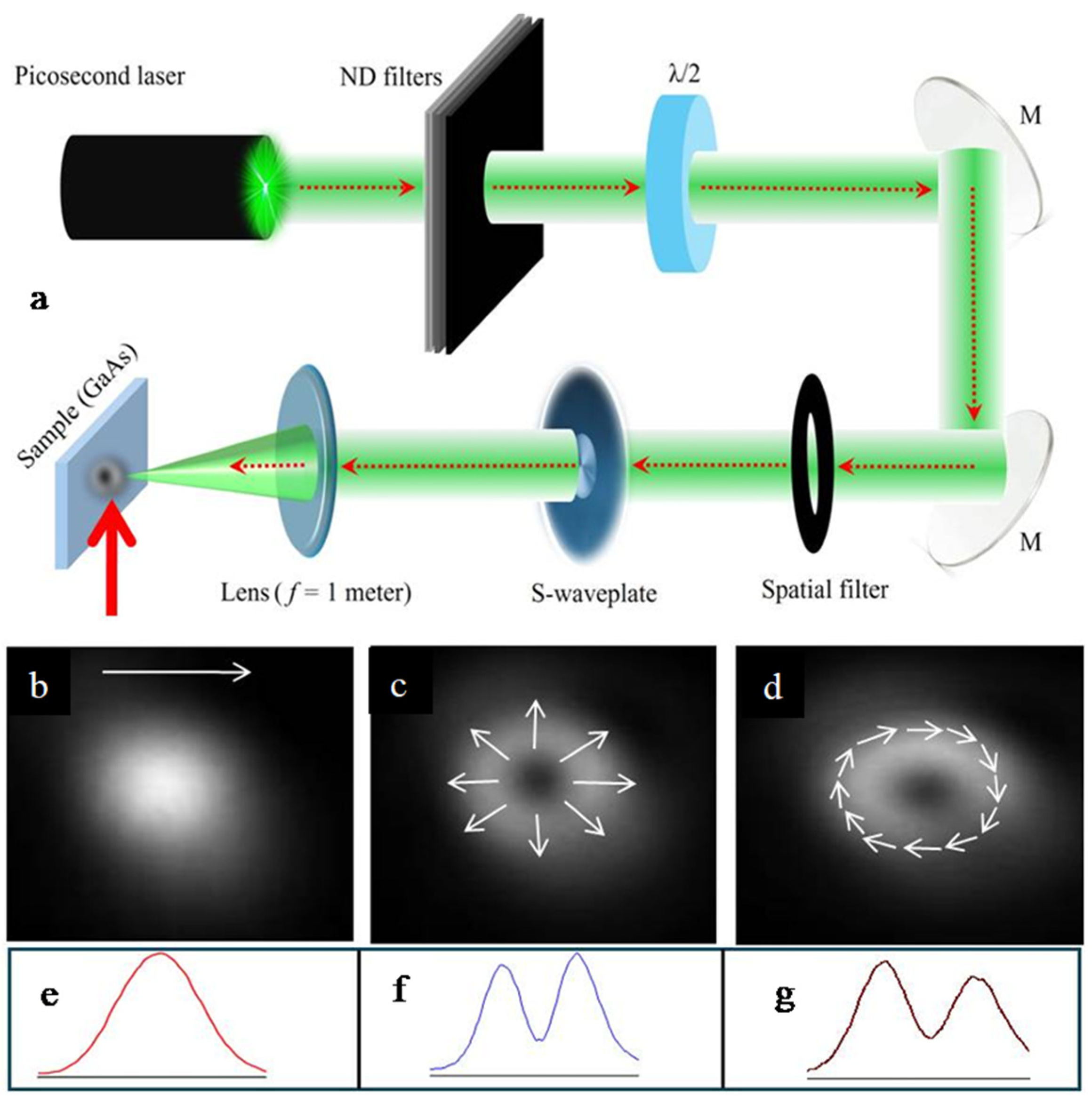
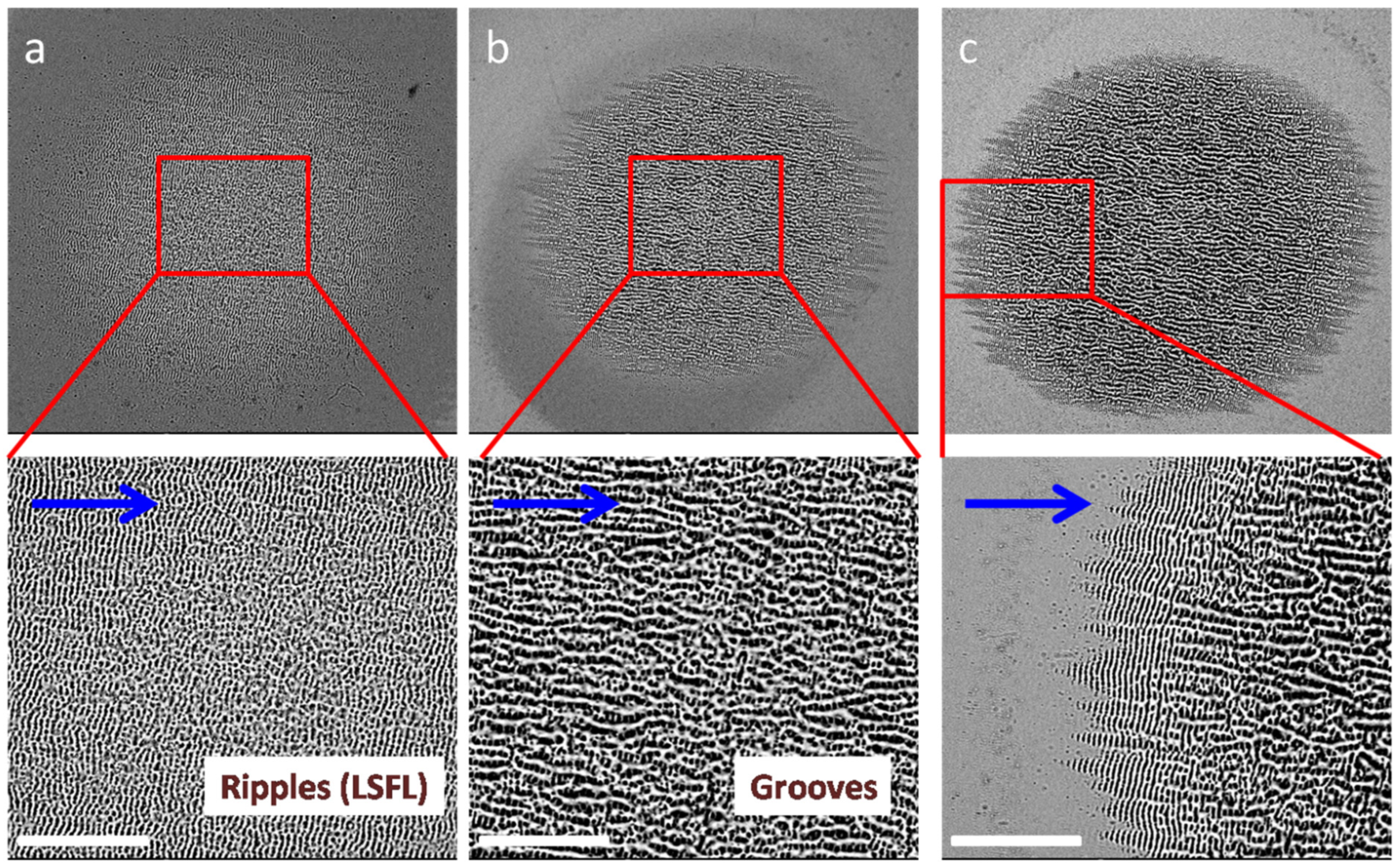


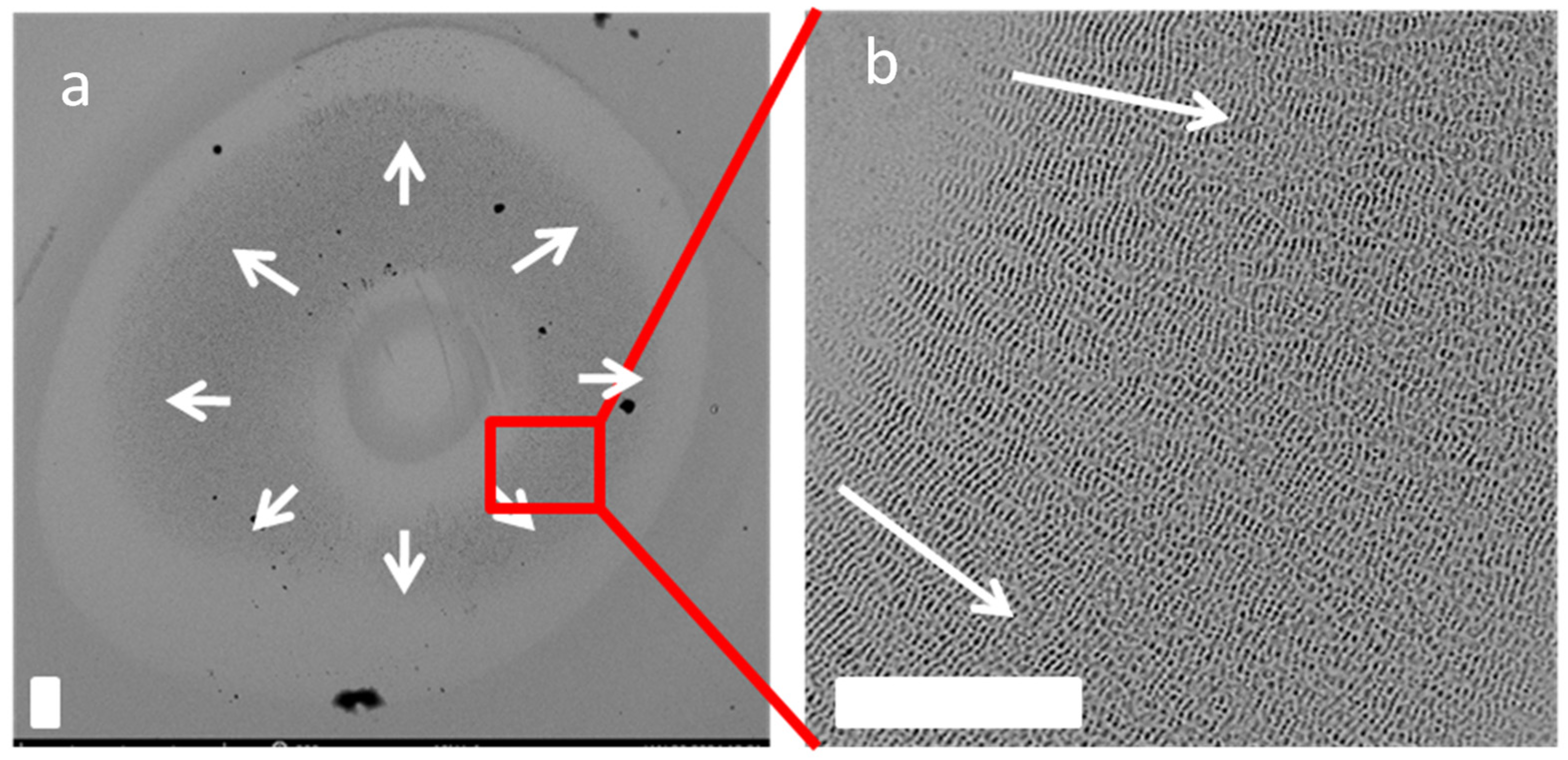
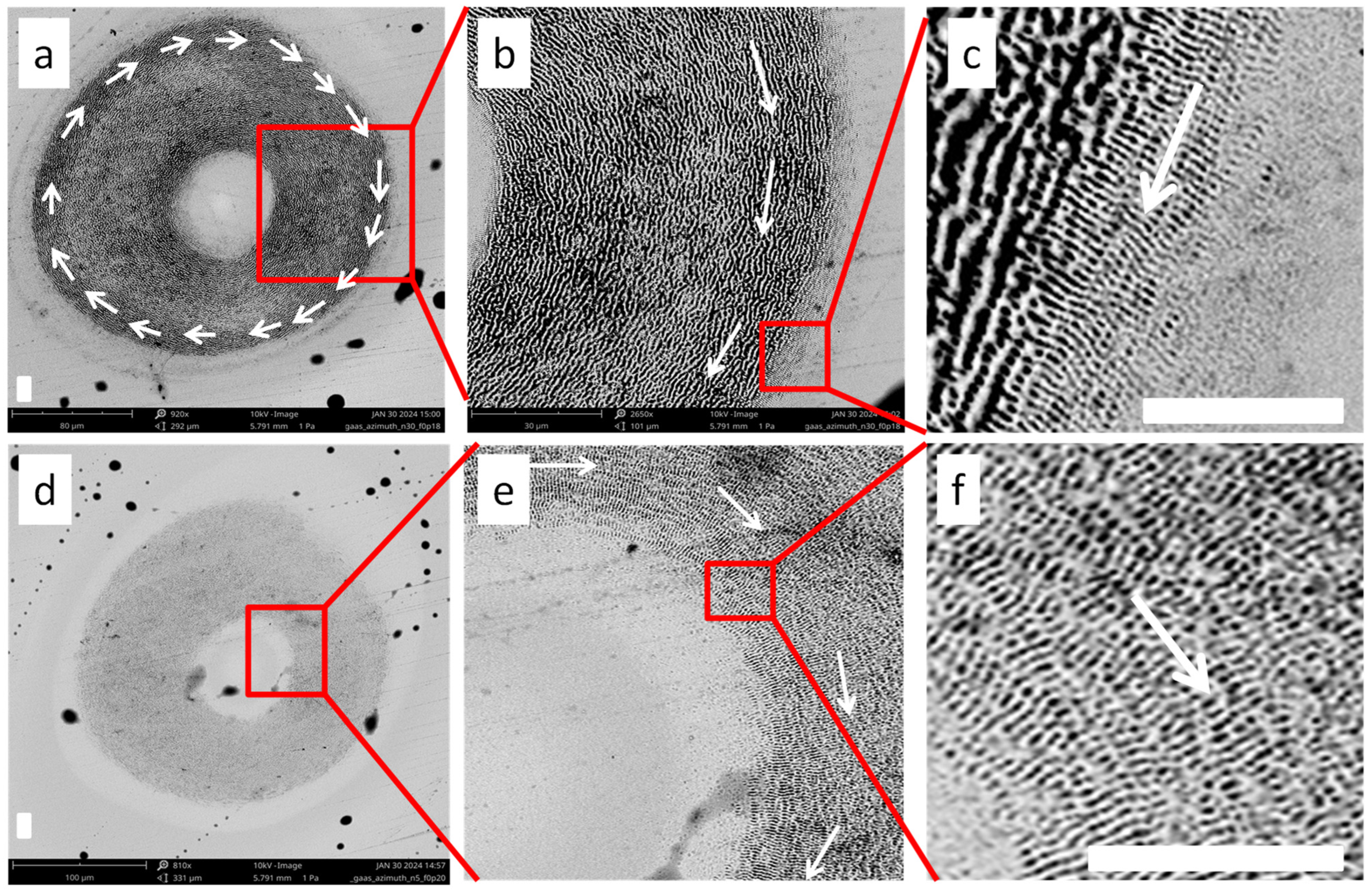

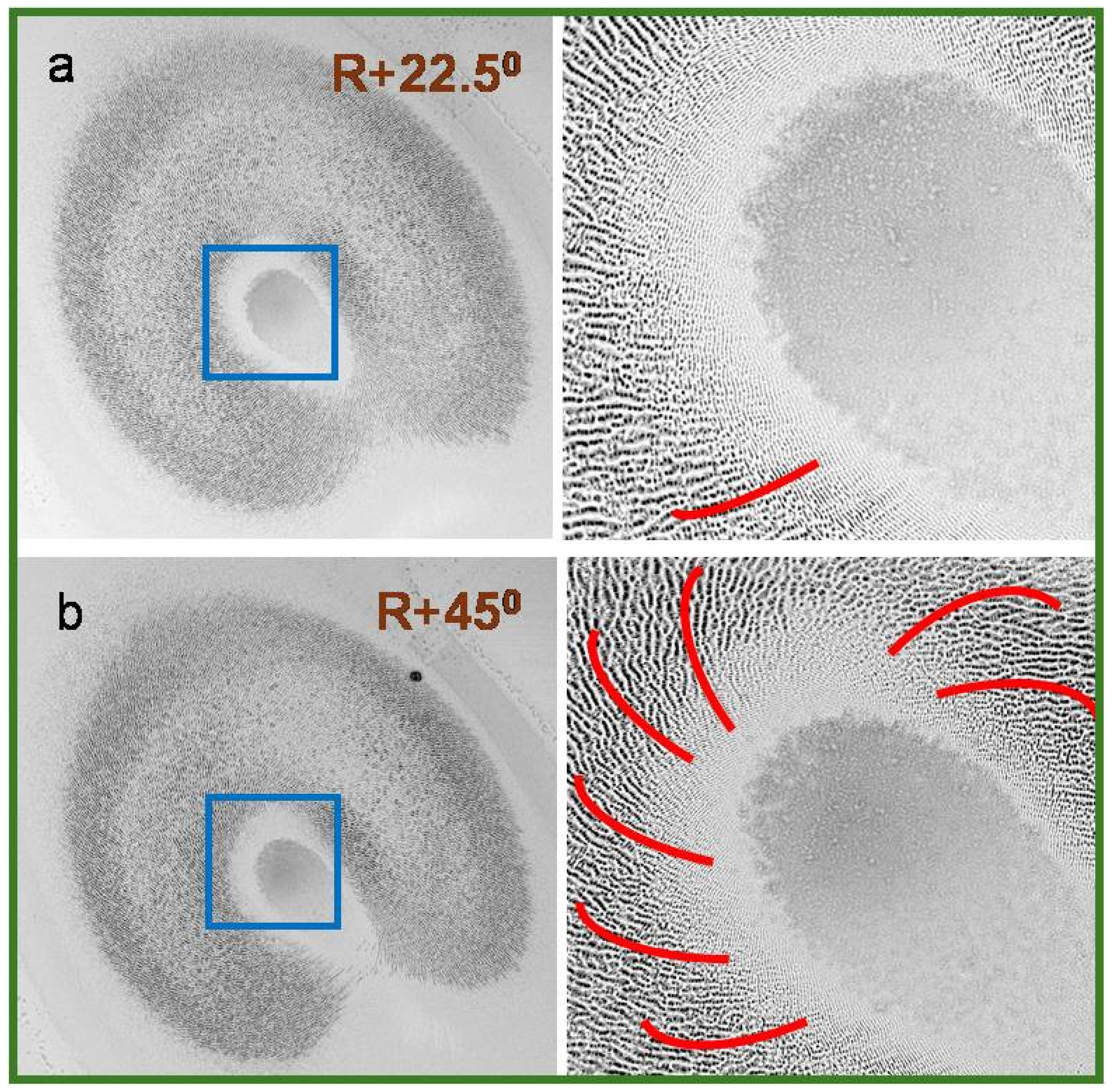
Disclaimer/Publisher’s Note: The statements, opinions and data contained in all publications are solely those of the individual author(s) and contributor(s) and not of MDPI and/or the editor(s). MDPI and/or the editor(s) disclaim responsibility for any injury to people or property resulting from any ideas, methods, instructions or products referred to in the content. |
© 2024 by the authors. Licensee MDPI, Basel, Switzerland. This article is an open access article distributed under the terms and conditions of the Creative Commons Attribution (CC BY) license (https://creativecommons.org/licenses/by/4.0/).
Share and Cite
Kalnins, K.; Kim, V.V.; Reddy, A.N.K.; Sarakovskis, A.; Ganeev, R.A. Spatially Variable Ripple and Groove Formation on Gallium Arsenide Using Linear, Radial, and Azimuthal Polarizations of Laser Beam. Photonics 2024, 11, 710. https://doi.org/10.3390/photonics11080710
Kalnins K, Kim VV, Reddy ANK, Sarakovskis A, Ganeev RA. Spatially Variable Ripple and Groove Formation on Gallium Arsenide Using Linear, Radial, and Azimuthal Polarizations of Laser Beam. Photonics. 2024; 11(8):710. https://doi.org/10.3390/photonics11080710
Chicago/Turabian StyleKalnins, Kalvis, Vyacheslav V. Kim, Andra Naresh Kumar Reddy, Anatolijs Sarakovskis, and Rashid A. Ganeev. 2024. "Spatially Variable Ripple and Groove Formation on Gallium Arsenide Using Linear, Radial, and Azimuthal Polarizations of Laser Beam" Photonics 11, no. 8: 710. https://doi.org/10.3390/photonics11080710
APA StyleKalnins, K., Kim, V. V., Reddy, A. N. K., Sarakovskis, A., & Ganeev, R. A. (2024). Spatially Variable Ripple and Groove Formation on Gallium Arsenide Using Linear, Radial, and Azimuthal Polarizations of Laser Beam. Photonics, 11(8), 710. https://doi.org/10.3390/photonics11080710





